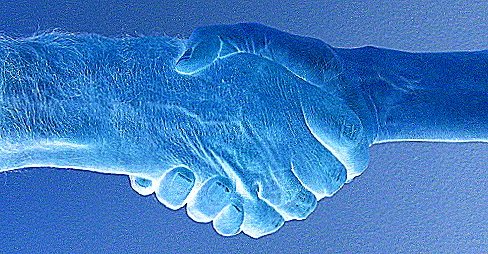A New Look at Cooperation
Today, let's activate a pleasure center. The University of Houston's College of Engineering presents this series about the machines that make our civilization run, and the people whose ingenuity created them.
New York Science Times writer Natalie Angier tells about a new study of human cooperation at Emory University. Investigators provide several new wrinkles on the old Prisoner's Dilemma game.
They enlisted 36 players. They were all women, thus reducing one dimension of variability. Each spent a few moments meeting the person she'd be matched with. Then each was put alone in a separate room and shown two buttons. You push one button to cooperate with the other player; you push the other to defect from her.
If both players push cooperate, then each wins two dollars (in real money). If both push defect, they win only a dollar each. But: if one pushes defect while the other pushes cooperate, the defector wins three dollars and the cooperator gets nothing at all.
So which button would you press? If you play only one round, there's no learning curve; you might be tempted to push defect and gamble on the other person's response. But cooperation allows you both to profit. In repeated rounds, some players cooperate for a while, then they trick their opponent by defecting.
In some rounds, players were told (or led to believe) that they were playing a computer. Against a computer (real or imagined) players became more ruthless -- often at their own expense.
But they usually bonded with human opponents, even though they were out of sight. Now and then, players who decided they were up against a human got themselves locked into repeated angry use of their defect button. (Who among us hasn't been led by anger into a lose-lose scenario?) But cooperation, and a maximization of mutual profit, was the norm. In fact, players often recovered from those bouts of defection and restored their cooperative bond.
Now the novel part of the study: One player from each pair was subjected to an MRI brain scan while she played. And here surfaced a far more basic reason for cooperating than mere profit. Each cooperative win-win play released dopamine. It, in turn, lit up the same pleasure centers as, say, eating chocolate does. Cooperation turns out to be an authentic physical pleasure.
Angier includes one remark that powerfully strikes home for me. She quotes a professor, who says,
I've pointed out to my students how impressive it is that you can take a group of young men and women ... have them come into a classroom, sit down and be perfectly comfortable and civil to each other.
During fifty years of teaching, I've repeatedly been struck by what a generally amicable place the classroom is. Even in an inherently competitive situation, students generally cooperate and seek out the greater mutual good.
Now we know why. Cooperating is a pleasure. It's one that we all forget, and deny to ourselves, from time to time. But when we can engage it, it is pleasure indeed.
I'm John Lienhard, at the University of Houston, where we're interested in the way inventive minds work.
(Theme music)
Angier, N., Why We're So Nice: We're Wired to Cooperate. New York Times, Tuesday, July 23, 2002, pp. D1, D8.
Owing to time constraints, I've been somewhat simplistic about cooperation here. For more on the subject, see https://engines.egr.uh.edu/subtle-texture-cooperation.
